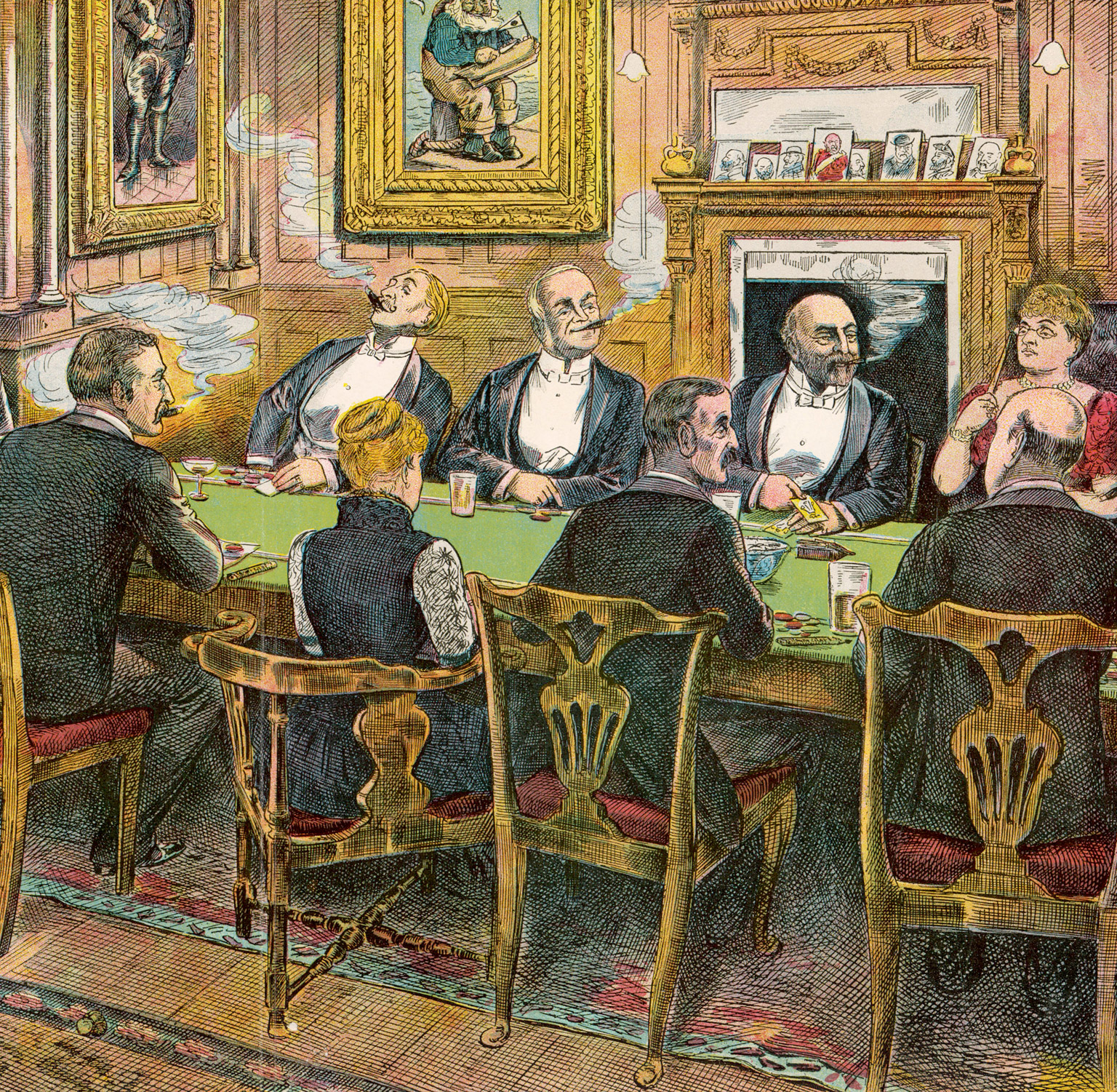
IN CONTEXT
Short story
US: September 1903
UK: October 1903
The Return of Sherlock Holmes, 1905
Honourable Ronald Adair Second son of the Earl of Maynooth.
Lady Maynooth Ronald’s mother.
Hilda Maynooth Ronald’s sister.
Edith Woodley Ronald’s former fiancée.
Colonel Sebastian Moran Ronald’s card partner.
Inspector Lestrade Scotland Yard detective.
This story sees the dramatic resurrection of Sherlock Holmes, after his apparent death at the Reichenbach Falls in Switzerland, killed along with his nemesis, Moriarty, in “The Final Problem”.
It is sometimes said that Conan Doyle was forced to bring Holmes back to life by public pressure. If that was the case, it took him a whole decade to yield. Given that that pressure is likely to have diminished rather than increased over the 10-year period, it seems more likely that Conan Doyle was swayed by the substantial financial deal being offered by the successful American periodical Collier’s Weekly. Therefore, the news of Holmes’s amazing return reached the US one month before it arrived in the UK, when the story was published in The Strand Magazine.
By the time Conan Doyle wrote “The Adventure of the Empty House,” it was the start of the 20th century and Queen Victoria had been dead for two years, yet he chose to set Holmes’s return in 1894, firmly in the Victorian era, and only three years after Holmes’s disappearance.
THE ROYAL BACCARAT SCANDAL

The card game in “The Adventure of the Empty House” was very likely based on the royal baccarat scandal (“the Tranby Croft affair”) of 1890. A group of aristocrats and ex-army officers attended a house party at Tranby Croft in Yorkshire in order to play baccarat, an illegal gambling game. One of the party was the future King Edward VII. While playing, one of the guests, Sir William Gordon-Cumming, was accused of cheating. Like Moran, Gordon-Cumming was a decorated army officer. He agreed to never play cards again in return for the guests’ silence. But when rumors began to circulate, Gordon-Cumming decided to sue his accusers for slander. Prince Edward was obliged to appear in court as a witness—the first time a royal prince had appeared in court for hundreds of years—and the story made headline news in Britain. Conan Doyle had met Prince Edward just a year before writing “The Empty House.” One of Adair’s card-playing associates is called Lord Balmoral (the name of the Queen’s Scottish estate), linking him unmistakably to the prince.
Murder on Park Lane
The story opens with Watson relating the strange murder of the Honorable Ronald Adair. He explains that the whole of London society was aghast at the killing of the young aristocrat, but Watson has taken a special interest in the case because he feels that the peculiar circumstances of Adair’s death were of the kind that would have appealed to his late friend Holmes. The doctor misses his friend’s company, and is keenly aware of the loss of Holmes’s unique crime-solving abilities to the wider community. Adair was the second son of the Earl of Maynooth, the governor of an Australian colony, and lived with his mother and sister on London’s exclusive Park Lane. A pleasant young man, he had no obvious enemies, and his only vice was that of playing cards. He was a member of several card clubs, and typically played whist, but apparently never gambled beyond his means. Just a few weeks ago, he had won £420 playing with his regular partner, Colonel Sebastian Moran.
On the evening of his murder, Adair returned home at 10pm and retired to his upstairs sitting room. When his mother, Lady Maynooth, came home later with his sister Hilda, she found his door locked from the inside. Failing to rouse him, she had the door forced open and discovered him dead—part of his head blown off by an expanding bullet.
"All day I turned these facts over in my mind, endeavouring to hit upon some theory which could reconcile them all."
Dr. Watson
The locked room mystery
There was no sign of a murder weapon in the room, nor any indication that anyone other than Adair had entered. Outside the window was a drop of at least 20 feet, and the flowerbed below showed no sign of disturbance. A brilliant marksman might have fired through the open window from the street, but no one outside on the busy Park Lane had heard the sound of a shot.
On the table at which the dead man was sitting were neat piles of money, and a sheet of paper with names and figures, suggesting Adair had been adding up his winnings and losses at cards. The sums were all modest, however, and so there seems to have been neither motive nor means for the young man’s murder. Watson is mystified. At this stage, it seems that Watson has set up the reader for a classic “locked room mystery” and is inviting the reader to solve the puzzle. However, the narrative then takes a different, and far more dramatic, twist, and soon the Park Lane mystery is all but forgotten.
The old bibliophile
Watson is standing outside Adair’s house on Park Lane, attempting to think like Holmes, and “to find that line of least resistance which my poor friend had declared to be the starting-point of every investigation.” Turning, he accidentally knocks a selection of books from the grasp of a hunched old man—clearly a collector of rare or unusual works—who happens to be standing nearby. Watson picks them up and tries to apologize, but the old man runs off angrily. Watson reaches home soon after, only for his maid to show in the very same old book collector to visit him.
The wizened old man apologizes for his earlier brusqueness and suggests that Watson might need some books to fill a space on his shelves. Watson turns around briefly to look at the shelf, and when he turns back he sees Sherlock Holmes in front of him, smiling. Out of sheer shock, Watson faints to the ground for the first time in his life.
When the doctor comes to, he sees a concerned Holmes bending over him, deeply concerned. “I owe you a thousand apologies,” he says. “I had no idea that you would be so affected.” Watson is overjoyed to see the dear friend he thought dead, and quickly recovers. It is a measure, perhaps, of the depth and trust in their friendship that Watson shows no resentment for the detective’s deception; he simply wants to know how on earth Holmes escaped from the Reichenbach Falls.
"Holmes!… Is it really you? Can it indeed be that you are alive?"
Dr. Watson
Holmes cheats death
It transpires that Holmes knew already that Moriarty was after him when Watson was lured back to the hotel by the fake message in “The Final Problem.” There, on the narrow path above the waterfalls, Holmes and Moriarty encountered each other. Moriarty gave Holmes a brief respite to write the farewell note Watson found later, before launching himself at Holmes. However, Holmes evaded him with a move from the Japanese martial art baritsu, and Moriarty slipped over the precipice to his doom. While the term “baritsu” does not exist, Conan Doyle was probably thinking of “bartitsu,” a martial art devised by British mining engineer Edward Barton-Wright (1860–1951). Barton-Wright had learned jujitsu in Japan, and combined it with other disciplines, including boxing, to create a new self-defense method that he named after himself.
Holmes explains that, as he watched Moriarty fall, he realized how useful it would be for everyone to think that he too had perished. There were at least three other dangerous men who wanted to kill him, and if they believed he was dead, they might become careless, which would enable him to track down and destroy them. Holmes therefore decided to fake his own death. With difficulty, he climbed the steep, rocky wall and hid on a ledge, while Watson and the local police examined the two footprints that led to the edge of the precipice, and reached the conclusion that Holmes had fallen into the deep chasm along with Moriarty.

Jeremy Brett plays the great detective in a 1986 television adaptation of “The Empty House.” Here he encounters Watson while disguised as an elderly bookseller.
The Great Hiatus
However, just when Holmes thought he was out of danger, a huge rock tumbled past him. He looked up the cliff to see one of Moriarty’s associates above, trying to kill him.
Holmes escaped, of course, knowing that everyone, bar the rock-hurler, thought him dead. For the next three years, a period Holmesians call the “Great Hiatus,” Holmes traveled the world. He relied on his brother Mycroft, his only confidant, to supply him with money and look after the 221B Baker Street lodgings. Conan Doyle gives the reader such a wealth of intriguing hints about what Holmes was up to in those three years that there is enough to fill a whole series of adventure books. Holmes tells Watson that after first going to Florence, Italy, he then spent three years traveling the world. He even posed as a Norwegian explorer called Sigerson—a character probably inspired by the Swedish explorer Sven Hedin, who traveled widely in Central Asia in the 1890s. Holmes mentions several places in Asia—all British imperial hot spots—and implies that he was working as a secret agent for the British government. Despite the story’s historic Victorian setting, Conan Doyle also wove up-to-the-minute global issues into Holmes’s travels.
Both Lhasa and Persia were focuses of the “Great Game”—the name introduced to the British public in Rudyard Kipling’s 1901 novel Kim to describe the long Cold War–like rivalry between the UK and Russia for dominance in Central Asia. Before he met Holmes, Watson had served as a medical officer in the British army in one of the main conflicts in the rivalry, the Second Afghan War (1878–1880). The references Holmes makes to his time in Lhasa surely relate to the spying, exploration, and intrigue in the build-up to the British army’s march into Tibet in December 1903, led by Lieutenant Colonel Francis Younghusband (1863–1942).
Holmes claims to have visited Khartoum, Sudan too—another imperial trouble spot. It was the scene of the defeat of British forces (led by General Charles Gordon) in 1885 by the Mahdiyah—the Sudanese Islamist rebellion. Gordon’s portrait hangs on the wall at 221B, and Conan Doyle himself traveled with the British army to Sudan in 1897, as a journalist, before the decisive Battle of Omdurman. There is no doubt that if Holmes was working in such a dangerous region, he would have done so undercover, making the most of his mastery of disguise.

During the “Great Hiatus,” as his three-year disappearance is called, Holmes certainly does not rest on his laurels. Among other adventures, he travels to Tibet, enters the holy city of Islam, and becomes a secret agent for the British government.
The house with a view
His undercover work complete, Holmes settled down to conduct chemical experiments in Montpellier, France. It was here that he heard of the Adair murder, news that finally brought him back to London. Holmes guesses that the murderer is Moran—the man who hurled rocks at him at Reichenbach—and this is his chance to finally flush him out.
It is a dangerous game, however. To catch Moran, Holmes must first become a target. He has been back in Watson’s life for only a short while before he is again taking his friend on a perilous mission. After tracing a circuitous route through obscure back streets in London, Holmes leads Watson to the back door of an empty house and inside.
Watson is amazed to see that the house fronts on to Baker Street and gives a clear view of their old lodgings. To his even greater astonishment, he can see Holmes himself silhouetted in the lighted upstairs window. Holmes explains that it is a wax decoy, and that Mrs. Hudson, now recovered from the shock of his return, is moving it around so it appears more lifelike.
After several hours waiting in darkness, they hear someone enter the house in which they are hiding. They shrink into the shadows and watch as an elderly gentleman in evening dress stealthily converts a cane into a rifle (the cane gun was a stylish but deadly accessory for Victorian gentlemen), carefully aims it out of the front window, and fires it, hitting the waxwork model of Holmes in 221B. Holmes and Watson grapple the man to the ground and Holmes then blows a whistle, summoning Inspector Lestrade and two other policemen, who quickly take hold of the prisoner. It seems Scotland Yard were also in on Holmes’s plans.

This commemorative coin was issued in 1994 to celebrate the 100th anniversary of Holmes’s return. The engraving shows Holmes and Watson overpowering Moran.
The murderer revealed
With the blinds drawn and the lamps lit, Holmes introduces their captive as Colonel Moran, ex-British army marksman and tiger-hunter in India: “the best heavy-game shot that our Eastern Empire has ever produced.”
“You cunning, cunning fiend!” Moran snarls, but Holmes responds that he is surprised a seasoned shikari (Urdu for hunter) could fall for the old decoy trick. Incensed, Moran challenges Lestrade to name the charges against him. Lestrade answers with “the attempted murder of Mr Sherlock Holmes,” but Holmes has other ideas. He knows that Moran’s cane is the remarkable airgun made for Moriarty by a blind German mechanic called von Herder. (The choice of a German maker for this fiendishly ingenious weapon reflects a growing concern at the time of writing over the threat posed by German expansionism and military technology.) Holmes goes on to explain that what makes von Herder’s airgun so remarkable is that it fires more or less silently, and has been adapted to shoot expanding revolver bullets. Thus Lestrade realizes that he has unwittingly caught the man all of London is looking for: the murderer of Adair. Moran shot Adair with his unique airgun through the open window of Adair’s second-floor sitting room.
"I think you want a little unofficial help. Three undetected murders in one year won’t do, Lestrade."
Sherlock Holmes

Hunting tigers was a popular pastime for the British Raj in India, and was seen as a badge of British manhood, superiority, and mastery.
The cheat accused
With Moran in safe hands, Watson and Holmes withdraw to 221B, where Holmes explains that he had been unable to move against Moran earlier without exposing and endangering himself. However, Adair’s card-playing link to Moran, and the unique nature of his death, made it plain that the murderer was Moran—and that this was Holmes’s opportunity to move against him.
When Watson asks why Moran killed Adair, Holmes says that he does not know for certain, but that he supposes Adair had realized that he and Moran had been winning only because Moran had been cheating. Adair must have threatened to expose him if he did not promise to stop playing cards, but Moran’s livelihood depended on gambling, and so he killed Adair to keep him quiet. At the time of the murder, Adair was probably trying to work out how much to repay the players they had cheated.
After Holmes has put his theory to Watson, he asks his friend, with unusual deference, “Will it pass?” And Watson replies, “I have no doubt you have hit upon the truth.” Behind this simple exchange lies a touching relief that the two friends are reunited at last, reinforcing the feeling that Holmes’s long absence is truly forgiven.
COLONEL SEBASTIAN MORAN
Like Moriarty, Colonel Sebastian Moran is a man who seemed to have everything going for him before he became a criminal. He was educated at Eton and Oxford, then embarked on a military career, during which he fought with distinction in the Second Afghan War (1870–1880), and became a marksman and tiger-hunter in India. But Moran suddenly changed, turning into the man Holmes describes as “the second most dangerous man in London” (after Moriarty). Holmes’s explanation is that Moran is the inevitable product of an evil strand in his ancestors, and Watson describes his appearance as conforming to the “criminal type.” Conan Doyle seemed to embrace this popular explanation of aberrant behavior in earlier stories, but here Watson responds to Holmes’s theory by noting, “It is surely rather fanciful”—an acknowledgement, perhaps, that by 1903, the theory was no longer so widely supported.
